As the New York Rangers approach the 30th anniversary of their last Stanley Cup win, it’s impossible not to also acknowledge the anniversary of the remarkable trade deadline moves that season as the 2023-24 deadline approaches.
Current Blueshirts general manager Chris Drury was a 17-year-old Rangers fan growing up in Trumbull, Conn., during that unforgettable run to a rare championship in 1993-94. Now, tasked with bringing the Cup back to New York, Drury surely has drawn lessons from the bold and risky moves of his counterpart in those days. Neil Smith transformed his roster just before the March 21, 1994 deadline – the date fell much later back then – in giving the franchise exactly what it needed to end a 54-year title drought.
Even Rangers fans who weren’t around or were too young to remember that season know of the consequential transactions that bolstered the roster in order to navigate the NHL playoff tournament – Stephane Matteau, Brian Noonan, Craig MacTavish and Glenn Anderson brought much-needed size, playoff experience and in Matteau’s case, one of the most famous goals in franchise history.
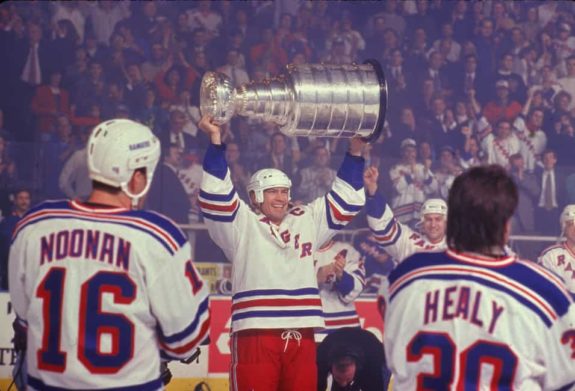
The Blueshirts didn’t stop there, of course. They also sent away high-scoring winger Mike Gartner to the Toronto Maple Leafs for championship-tested Glenn Anderson on that deadline day, and there was also what turned out to be a critical move in March 1993, when the Rangers dealt young center Doug Weight to the Edmonton Oilers for veteran forward Esa Tikkanen.
The irony, though, is that while those trades are amongst the most important in franchise history, they cost the organization an exorbitant amount of young talent in a series of unbalanced deals that Smith was willing to make as he and the team pursued an end to the “1940” taunts endured by the Rangers at their rivals’ home arenas.
While Drury faces a situation somewhat similar to the one Smith did, with his largely veteran team sitting atop the Metropolitan Division and seemingly in position to make a deep playoff run, the current GM won’t make such lopsided trades before this season’s March 8 deadline to reach the top of the championship mountain. There are multiple reasons for that, the most significant being that the NHL – and other sports leagues – generally don’t make swaps like that anymore.
So it begs the question, at least in this space – would the Rangers, who went all out organizationally in 1994 to finally win, have been able to acquire the players they did for much less had the conditions of today’s NHL been in place 30 years ago? And if so, would they have been able to capture more than one Cup during that era?
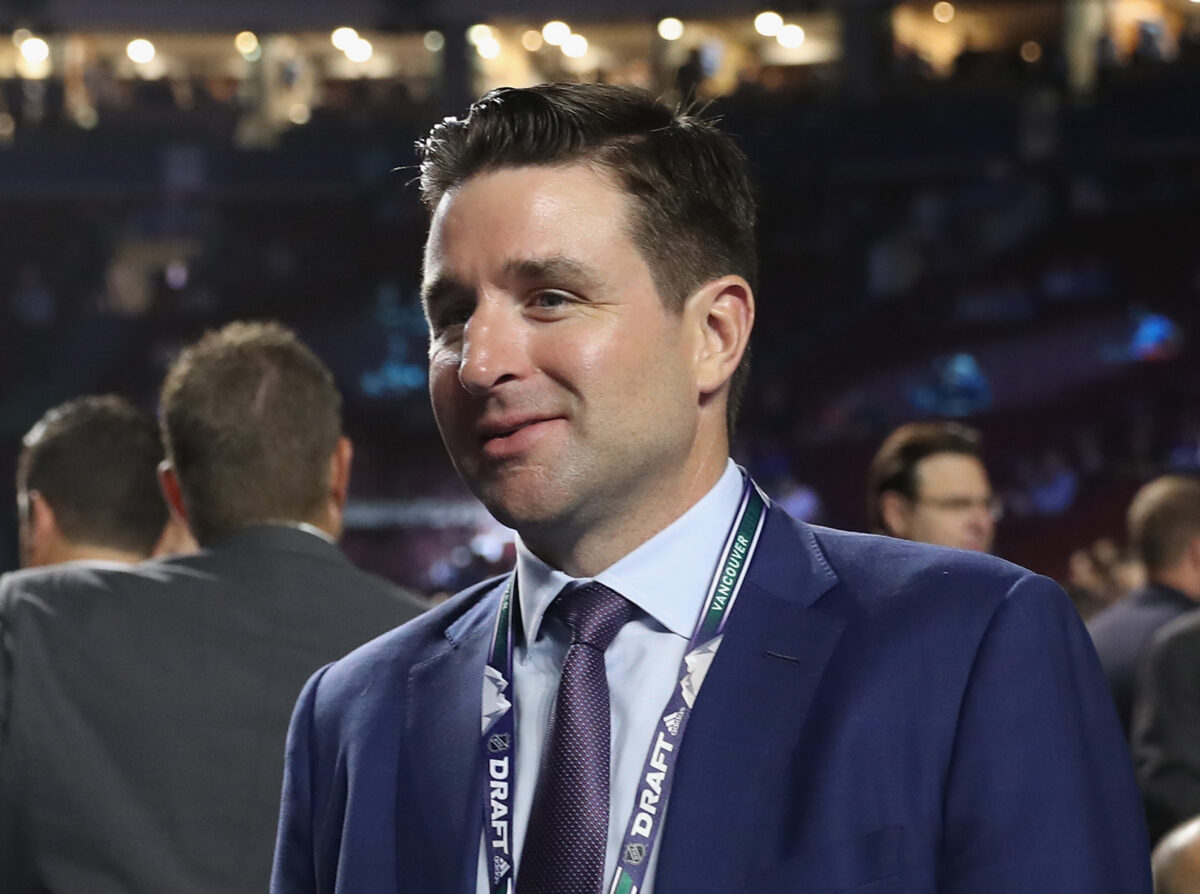
We’ll never know the answer to those questions, of course, but it’s fun to ponder the possibility. So first, let’s recap the trades of March 21, 1994, which paved the way for the magical night of June 14, 1994, the last time the Stanley Cup was lifted on the Madison Square Garden ice:
Rangers Trade RW Tony Amonte and LW Matt Oates to Chicago Blackhawks for LW Stephane Matteau and RW Brian Noonan
This trade was the most successful of all of Smith’s moves when it came to obvious contributions in capturing the Cup. The 6-foot-4, 215-pound Matteau’s double-overtime goal that sent the Rangers past the New Jersey Devils in Game 7 of a classic Eastern Conference Final and into the Stanley Cup Final will live forever in team and NHL lore, but Matteau scored five other goals during that postseason – two of those coming against the Devils, including the OT winner in Game 3.
Noonan, who like Matteau played for then-Rangers coach Mike Keenan in Chicago, was another big grinder who delivered some key offense in those playoffs, with four goals and 11 assists in 23 games. The versatile right wing scored two even-strength goals and two power-play goals in both the regular season and the postseason after being acquired.
Why It Hurt:
Dynamic winger Tony Amonte was anything but an unknown commodity when he became the centerpiece of that fateful swap – he had totaled 145 points in 162 games over the 1991-92 and ’92-’93 seasons, his first two in the NHL. Like so many players, though, he had run afoul of Keenan in 1993-94 – and as was often the case with “Iron Mike” at his previous coaching stops, the reasons for it weren’t entirely clear. Perhaps in part because of that, Amonte’s production had fallen off that season, with 16 goals and 22 assists in 72 games with the Rangers when he was dealt.
Related: Kovalev and the Rangers: Eventful, Successful and Disappointing
In new surroundings, though, it should have been utterly predictable that Amonte would go back to continuing his rise to stardom. The Rangers’ fourth-round draft pick in 1988 would record 268 goals and 273 assists in 627 games for the Blackhawks, posting three 40-goal seasons and a career-best 84-point effort in 1999-00. He played for three other teams and finished his career with 900 points in 1,174 games.
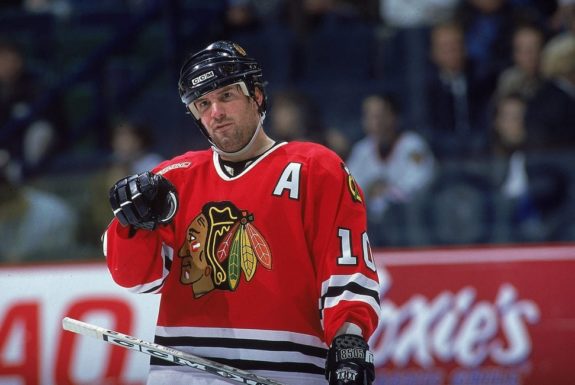
The Amonte trade wasn’t Rick Middleton to the Boston Bruins, and the Rangers don’t win the Stanley Cup without this deal. Yet more than any other move at that deadline, Amonte’s highly-productive career after leaving New York served as a long, painful reminder of the cost of that championship.
Rangers Trade RW Mike Gartner to Toronto Maple Leafs for RW Glenn Anderson and Minor Assets
Mike Gartner occupied an even lower tier than Amonte on Keenan’s list of guys who apparently didn’t fit his program. While Keenan wanted to use Amonte to acquire Matteau (more on that later), the coach simply wanted Gartner gone, complaining constantly to Smith about Gartner’s lack of grit and inability to translate his high-scoring regular-season ways to the playoffs. Smith, who had little choice but to pick his battles with Keenan in the coach’s one turbulent but Cup-winning season in New York, knew Keenan wasn’t going to let it go. The GM moved Gartner, who had been a trade steal by Smith in 1990, for Anderson, who like numerous Rangers on that team had been a core piece of the Oilers’ 1980s dynasty.
Why It Hurt:
Of all of Smith’s moves that brought the elusive Cup to Broadway, this was the most useless. Anderson, nearing the end of his career and far removed from his days as a perennial 40- and 50- goal scorer in Edmonton, made little impact for the Rangers, recording six points in 12 regular-season games and six more in the 23 playoff games that spring. He departed that offseason, eventually joining Keenan with the St. Louis Blues following the NHL’s lockout after the coach’s ugly divorce from the Blueshirts.
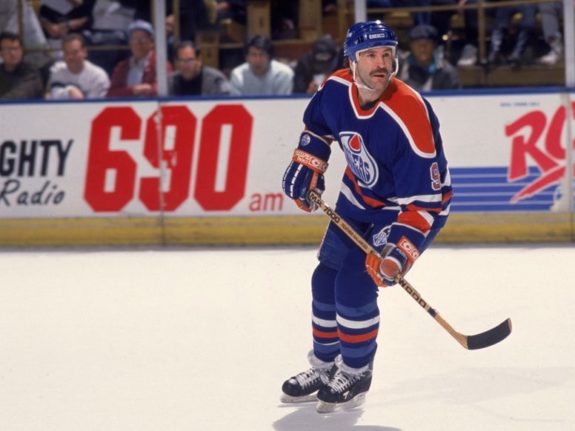
Gartner just went on scoring after leaving New York, delivering 97 goals and 79 assists in 272 games with the Leafs and then-Phoenix Coyotes to close his career with 708 goals and 627 assists in 1,432 games en route to the Hall of Fame. The right wing had fashioned three consecutive 40-goal seasons for the Rangers just prior to Keenan’s arrival.
Rangers Trade C Todd Marchant to Edmonton Oilers for C Craig MacTavish
Another champion Oiler was Smith’s target with this trade, with the club seeking more size down the middle along with sound defensive play and faceoff prowess – with MacTavish fitting the bill perfectly. He was an important piece of the Cup-winning roster, scoring four goals with two assists and a plus-6 rating in 12 regular season games for the Rangers and playing all 23 postseason games that spring. MacTavish’s most memorable contribution was his winning of the final faceoff in Game 7 of the Stanley Cup Final that sealed the Blueshirts’ 3-2 victory.
Why It Hurt:
In keeping with a theme of the Rangers’ 1994 deadline deals, Marchant went on to a productive NHL career. Never a star, he nonetheless recorded 498 points in 1,195 games, excelling as a speedy bottom-six forward who also killed penalties over 17 seasons. He scored 136 goals with 207 assists in 678 games for Edmonton.
Rangers Trade C Doug Weight to Edmonton Oilers for F Esa Tikkanen
While this trade was made a year earlier than the 1994 deadline, it must be mentioned, as it was in the same vein of the club’s deals to fortify the roster with experience for deep playoff runs at the expense of young talent – and, like the other trades, it was costly. Tikkanen, then 29, was a key contributor to the Rangers’ championship, recording 54 regular-season points in 1993-94 and eight points during the postseason, with his versatility as a scorer/checker/high-end pest proving critical to that storied playoff run.
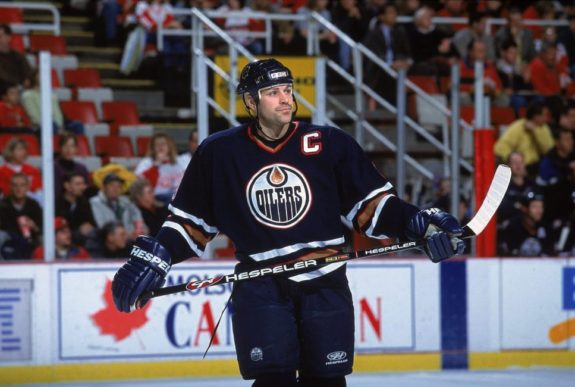
Tikkanen joined Anderson with the Blues the next season as part of a lopsided trade approved by the NHL as compensation for Keenan’s departure, having played a total of 106 games with the Rangers (though he would return to the team in a March 1997 trade and make a major impact as the Blueshirts reached the Eastern Conference Final).
Why It Hurt:
Doug Weight, the Rangers’ second-round pick in 1990, was highly-regarded within the organization, and he’d go on to show why over a 19-year career in which he recorded 1,033 points in 1,238 games for six teams. An elite distributor, Weight posted 104 points for the Oilers two seasons after being acquired and also had 90- and 82-point seasons with Edmonton. He won the Stanley Cup with the Carolina Hurricanes in 2005-06.
Rangers Paid Huge Cost in Successful Pursuit of Stanley Cup
You would be hard-pressed to find a Rangers fan old enough to have appreciated that magical playoff push to a championship that had eluded the organization for 54 years, who is bothered now by the price of the deadline trades. The fact remains, though, that Smith, acting with the kind of bold, daring, go-for-broke approach that’s become exceedingly rare in personnel transactions in major pro sports, was willing to undertake a significant talent drain in exchange for ending the Rangers’ title drought.
It worked, but could the reshaping of the team have been done in a way that didn’t cripple the organization’s next wave of youth behind home-grown franchise stars Brian Leetch, Mike Richter, Alexei Kovalev and Sergei Zubov? Viewed through the lens of today’s salary-capped NHL, which exists in a pro sports landscape in which teams strive to assign exacting values to tradeable assets and try to minimize risk when sending away young, cost-controlled players, the flurry of trades made by Smith appears downright shocking.
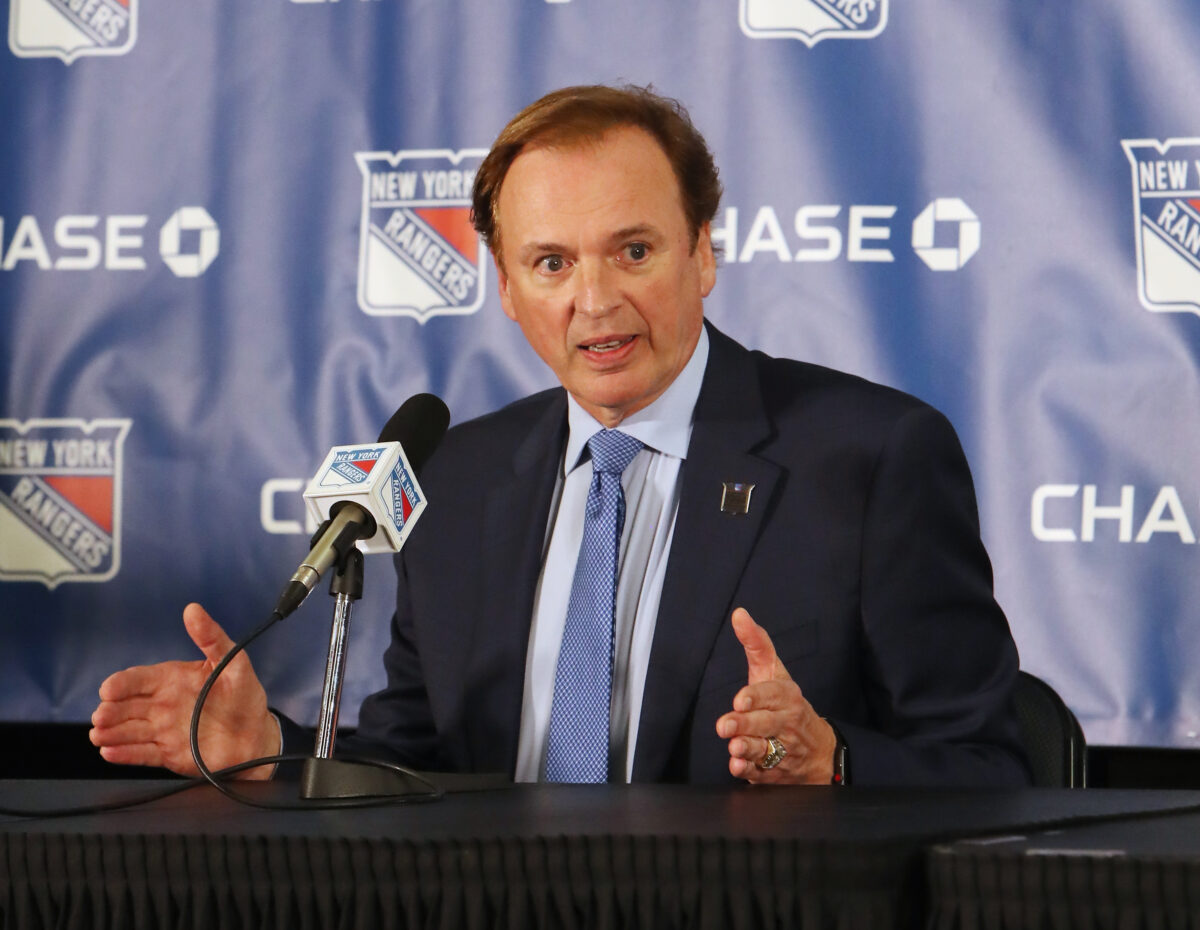
So why pay so much? Because those deals had everything to do with the extenuating circumstances surrounding the team and the time. The Rangers, having added Mark Messier to a rising core in an October 1991 trade, were developing into a championship contender, and Smith knew it. That window to win a Cup, something the club hadn’t had in any realistic sense for years, had to be treated as the golden opportunity that it was. That meant GM and organization simply didn’t have the option to worry about the future beyond that season, given the franchise’s tortured history.
Adding to the already intense pressure were the season-long machinations of Keenan, who Smith knew was going to be very difficult to work with, but who was the right coach at the right time for his team. Along with the relentless demands to get rid of Gartner, Keenan was also insisting that Matteau by acquired at any cost, wanting Smith to move Amonte for him straight up if necessary.
That was a rare line Smith wouldn’t cross that season, eventually getting Blackhawks general manager Bob Pulford to add Noonan to the trade. The deal, however, was still lopsided, and Pulford knew he was going to be able to extract a significant return for Matteau and Noonan, neither of whom were elite offensive players as Amonte was. That was in large part because Pulford was aware of the Rangers’ Cup-or-bust stance, and also his understanding of the demanding ways of Keenan, having worked with him in Chicago for four years.
Nowadays, adding complementary players like Matteau, Noonan and Tikkanen, along with aging veterans Anderson and MacTavish, wouldn’t cost the Rangers close to the haul of Amonte, Weight, Marchant and Gartner. Along with youngsters being more highly valued now for numerous reasons, teams tend to use draft picks more than prospects for such deals, pushing the risk off to the future rather than giving away cheap, potentially high-end talent that can help the team much more quickly than picks do.
There’s little question that the Rangers weren’t able to remain competitive for longer after essentially gutting their organization for the one championship. While Leetch, Richter, Kovalev, Zubov and others established themselves as in-their-prime difference-makers for a championship team, Smith and the Blueshirts moved decisively when they saw the chance to lift the Cup, sacrificing more potential franchise cornerstones in the process.
Could the Rangers have won more than one championship had Smith been able to acquire the critical, yet nonetheless complementary, pieces for less than he paid? Who’s to say, and perhaps that wasn’t possible in an entirely different era of personnel acquisition – and because of the situation the Rangers found themselves in during the 1993-94 season. Fans old enough to have gone along on that incredible journey of the spring of 1994, however, don’t care – even if they might quietly wonder what could have been from time to time.
